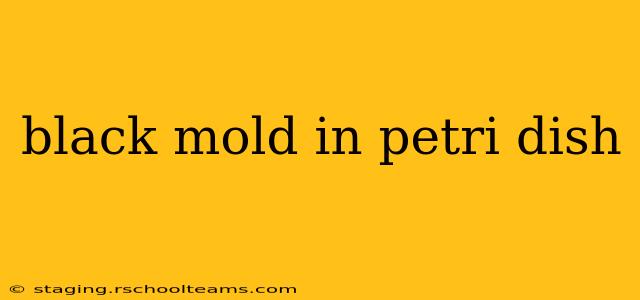Black mold, a term often used colloquially, actually refers to a variety of dark-colored fungi. Finding it growing in a petri dish raises several important questions regarding identification, growth conditions, and potential health risks. This guide will delve into these aspects, providing a comprehensive overview for researchers, students, and anyone curious about this common laboratory observation.
What Types of Mold Can Appear Black in a Petri Dish?
Several fungi species can exhibit a black or dark-colored appearance in a petri dish. It's crucial to understand that visual identification alone is insufficient for definitive species identification. Microscopic examination and potentially further laboratory tests are necessary for accurate identification. However, some common genera known to produce black or dark-colored colonies include:
- Aspergillus species: Many Aspergillus species produce colonies with a dark green, black, or brown pigmentation. Some are relatively harmless, while others produce mycotoxins that pose significant health risks.
- Stachybotrys species (Black Mold): This genus is often associated with the term "black mold" and is known for its association with water-damaged buildings. It's important to handle cultures of Stachybotrys with extreme caution due to the potential for mycotoxin production.
- Cladosporium species: While often appearing dark olive-green or brown, some Cladosporium species can appear nearly black under certain growth conditions. They are common airborne fungi and generally less hazardous than Stachybotrys.
- Alternaria species: These fungi often produce dark-colored colonies and are prevalent in the environment. While typically not highly toxic, they can be allergenic.
How Does Black Mold Grow in a Petri Dish?
The growth of black mold in a petri dish depends heavily on the nutrient medium used and the environmental conditions. Key factors include:
- Nutrient Availability: A rich nutrient agar provides ample resources for fungal growth, leading to rapid colony expansion. The specific nutrients in the medium can also influence the pigmentation of the mold.
- Temperature: Optimal temperatures for fungal growth vary by species, but generally fall within a mesophilic range (around room temperature).
- Humidity: High humidity is crucial for fungal growth and spore dispersal. A moist environment within the petri dish facilitates colonization.
- Oxygen: Most molds are aerobic, requiring oxygen for growth. Proper ventilation within the incubator or growth chamber is important.
- Light: While not essential for growth, light can influence pigmentation and spore production in some species.
Is Black Mold in a Petri Dish Dangerous?
The danger posed by black mold in a petri dish depends entirely on the specific species present. Some species are relatively harmless, while others produce mycotoxins (toxic compounds) that can cause a range of health problems, including allergic reactions, respiratory issues, and in rare cases, more severe illnesses. Never attempt to identify a mold species based solely on its appearance. Proper handling and disposal procedures are essential, especially when working with unknown fungal isolates.
What are the safety precautions when handling petri dishes with black mold?
Working with fungal cultures requires stringent safety protocols:
- Personal Protective Equipment (PPE): Always wear appropriate PPE, including gloves, lab coats, and eye protection. A respirator with a HEPA filter might be necessary depending on the species and the potential for airborne spores.
- Containment: Work within a biosafety cabinet (BSC) whenever possible to minimize the risk of spore dispersal.
- Sterile Techniques: Employ proper aseptic techniques to avoid contamination.
- Disposal: Dispose of cultures according to institutional guidelines. Autoclaving is the most effective method for sterilization.
What are the different types of black mold?
As mentioned previously, "black mold" is a general term, not a specific species. Many different fungi can exhibit a dark pigmentation. Accurate identification requires microscopic examination and potentially advanced laboratory techniques. This is why it's crucial to consult with a mycologist or a qualified laboratory professional for proper identification and risk assessment.
How can I identify the type of black mold in my petri dish?
Visual identification is unreliable. Microscopic examination of the fungal structures (hyphae, spores, etc.) is essential for species identification. This often requires specialized staining techniques and expertise in fungal morphology. Further molecular techniques (DNA sequencing) might be needed for precise identification in some cases.
How do I prevent black mold growth in my petri dish?
Preventing black mold growth relies on maintaining sterile conditions:
- Sterile Techniques: Practice strict aseptic techniques throughout the entire process, from media preparation to inoculation and incubation.
- Sterile Equipment: Ensure all equipment and materials are sterilized before use.
- Proper Incubation: Maintain appropriate incubation conditions to avoid excessive humidity or temperature fluctuations that could favor fungal growth.
- Regular Cleaning: Regularly clean and disinfect your work area and equipment.
This detailed guide provides essential information regarding black mold found in petri dishes. Remember, always prioritize safety and seek professional identification if you encounter unknown fungal cultures.
